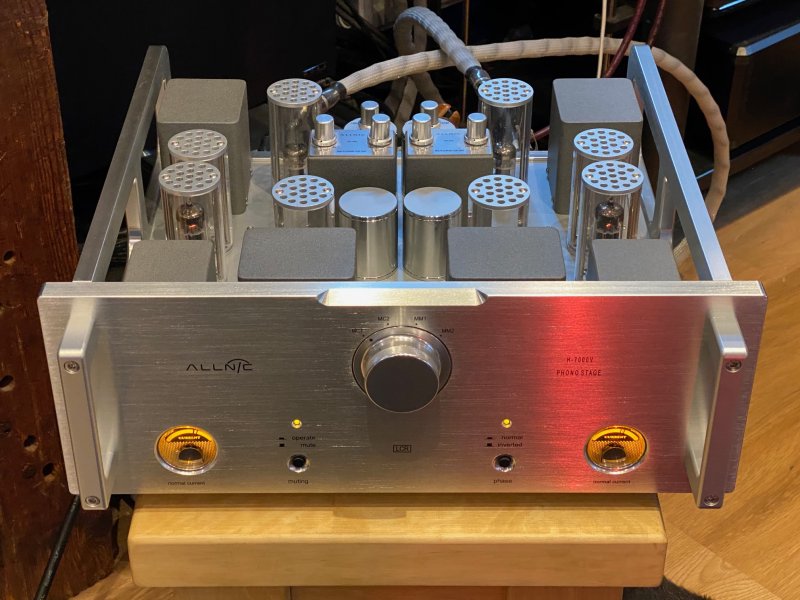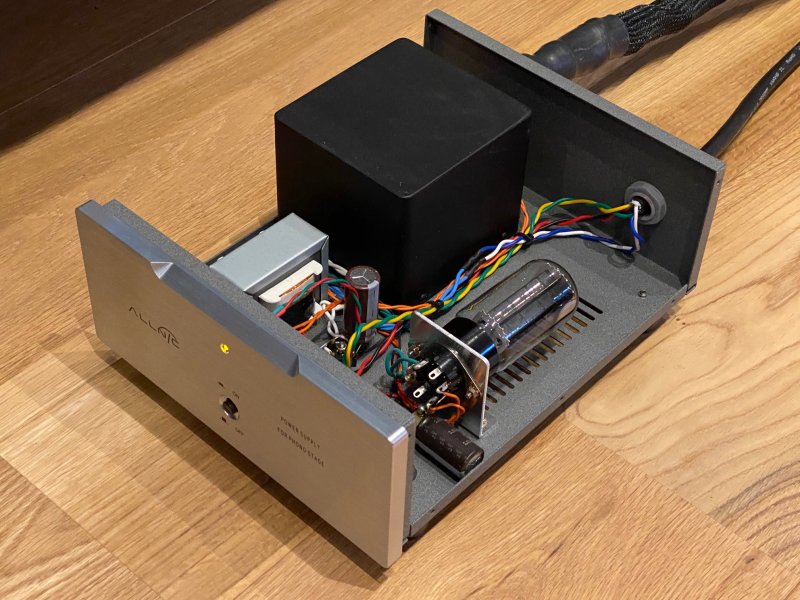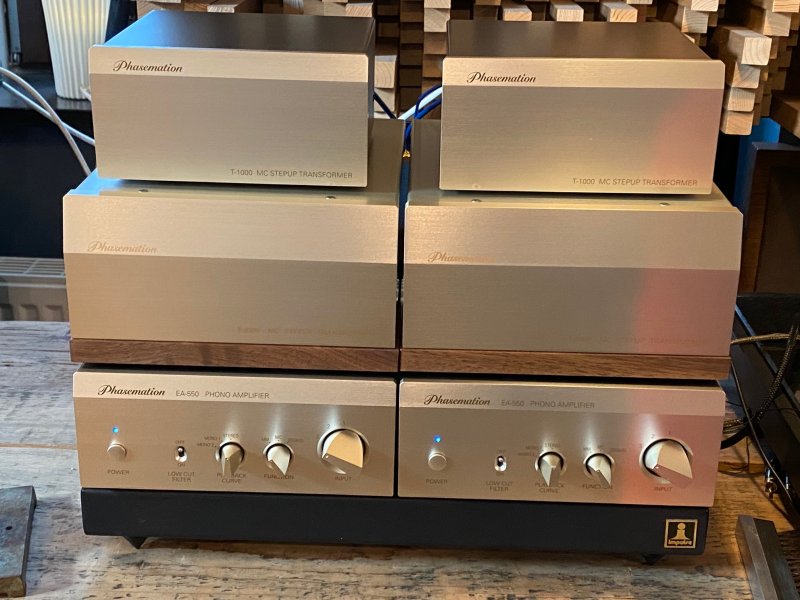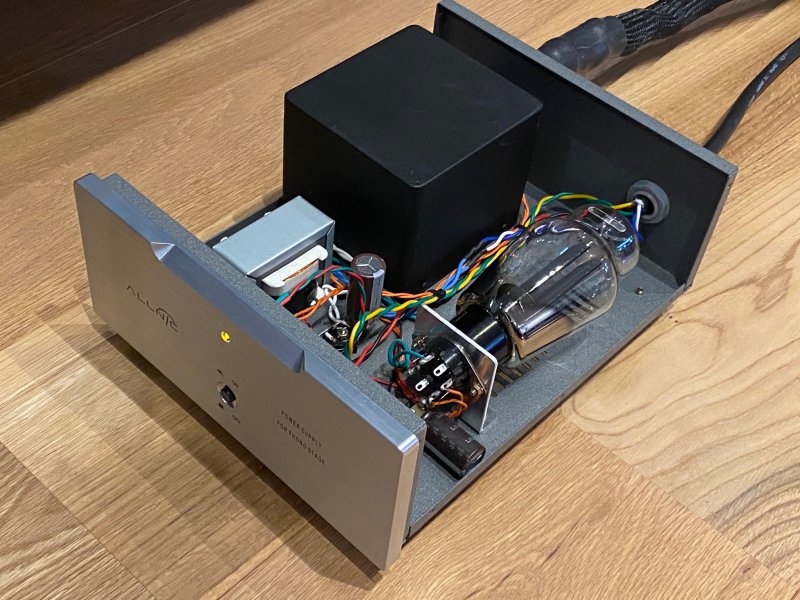I can write in more detail
(out of a thread I have contributed in a German Forum):
I have now listened to music for many hours and I can give some first impression:
Phasemation EA 550 with Phasemation T-1000 step up
plays exactly as the Creator had it in the specifications, ie very authentic, very realistic. My two co listeners both said spontaneously "that's right". Percussion instruments in particular come with such an exact timing that you automatically bob, the sound character can be described as "fast". The spatial positioning seems realistic, and the size of the instruments fits together. Voices come with expression and energy without appearing excessive. All in all a convincing performance that arouses interest in the larger Phasemation phono preamps.
Phasemation EA 550 with Phasemation T-2000 step up
If you connect the next larger Phasemation transformer with the EA 550, the sound becomes calmer, feels more majestic, deeper, more precise, more energetic, simply better in all respects. It is hard to believe that you are listening to the same phono stage.
Allnic H700v in the step up only version with Kron RK Edition Rectifier.
If you switch on the Allnic H7000v, the music suddenly starts to live in a fascinating way, you are emotionally drawn into the music, violins, female voices, etc. cause goose bumps. A fascinating journey into the heart of music, which makes you forget that voices can sometimes seem a bit too big, that the room doesn't seem quite as stable due to the dynamics.
Allnic H700v, Kron RK Edition Rectifier with Phasemation T-2000 step up
If you control the Allnic via the Phasemation T-2000 transformer, it becomes clear what incredible quality the MM branch of the Allnic H7000v has. My co listeners described the jump as the "next level", because size mapping, stability with large volume changes, resolution in the bass range, details in the high frequency range simply increase significantly with the T-2000. At the MC input of the Allnic we played a 4000, - pickup (Etsuro Blue) and at the MM input, supported by the T-2000, a 1000, - eur pickup (Phasemation PP 200), both TA have 4ohm DC resistance. Even the cheaper pickup sounded in a class above the T-2000 that you couldn't believe how "inexpensive" the PP-200 actually is. With this combination, ie PP-200 on T-2000 and Allnic H7000v, we usually let the evening fade away, because it was simply the most emotionally involving set up.
Boulder 2008
If you then connect the Boulder, you become aware of the details that you have left out until now. The Boulder is able to explain all details precisely and calmly over the entire frequency range. The better the recording, the more fascinating the result. If the recording is no good, you don't want to continue listening to the Boulder. The resolution at the lower end of the frequency is especially fascinating; you sometimes think that the Boulder is an octave lower than other phonopres. In this sense the perfect PhonoPre, you would need one for the production of records. But unfortunately I not only have "perfect" records, but also quite a few indie records that sound pretty weak and not very involved on the Boulder. In addition, even with perfect recordings, these are sometimes presented very distantly and with little involvement. It's a bit like not standing in the middle of the dancing crowd at a concert, but sitting above everything in the Lounge. Possibly the best sound, but somehow you are not at the "real"concert
Boulder 2008 with Phasemation T-2000 step up
Together with the Phasemation T-2000 step up, the Boulder clearly gains in emotionality in its reproduction, you prefer to follow voices and acoustic instruments, but once you've heard the Allnic's emotional address, you only hear information and no music at the Boulder.
At least if you like playback through the Allnic's tubes

. On the other hand, this rendering is a pleasant compromise between two worlds. Ultimately, however, it is always important to me which installation you end the evening with after all the comparisons and renovations. And now for the second time the Allnic is there with the T-2000 and making nicely music.
If you then switch to the EA 550 with the T-2000, you are also fascinated by how much of the character of the Allnic / T-2000 combination obviously comes from the T-2000 and is also transported in conjunction with the EA-550.
With regard to Boulder 2008, I now know that the combination with the Audionet STERN is not one of the ideal.
At the Koda Takuma K10 or the Jeff Rowland Criterion, the Boulder 2008 played out much more emotionally, maybe I will now park the Boulder in the second facility until a another opportunity comes again that fits the boulder better ...
The winner of the weekend is definitely the Phasemation T-2000 step up, which managed to improve all 3 connected PhonoPres. This will definitely stay that way!
A combination of the liveliness of the Phasemation EA-550 preamplifier and the euphoric tube reproduction of the Allnic would now be the sought-after next step. Could it be an Allnic H8000v, or a Phasemation EA 1000 or EA 2000, or a phono preamplifier that I haven't seen before?
At least I now have a more concrete idea of the direction in which the next sonic step should go. A good MM input is definitely required so that the Phasemation T-2000 step up can also be connected.
ps
the full story of my Phonostage journey can be found in a German Forum:
Google translate makes reading easy.





